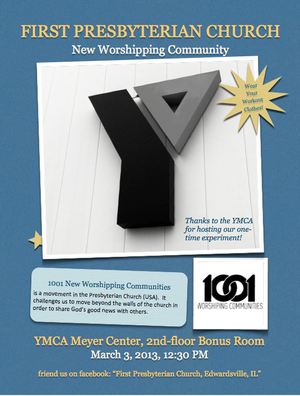Call it a classic Presbyterian moment—a committee begins to study an issue and then determines that action is needed.
“We got exposed to the vision of the 1001 New Worshiping Communities initiative,” says pastor John Hembruch of First Presbyterian Church in Edwardsville, Ill.
A ministry team of the congregation began studying "1001" during Lent. “We quickly realized it would be pretty weak to study the idea without getting out and trying it,” Hembruch said.
So the ministry team decided to see if they could start a new worshiping community. After speaking with more than 25 different community and business leaders — churched and unchurched — they came up with a grand experiment.
“We decided for a month of Sundays, we would create and bring a new worship service into our neighborhood in places where people were,” says Hembruch. “We went to an urban storefront, a used bookstore; to a brand new health club; to a student center on a college campus; and to a retirement community.”
At each location, First Church’s ministry team saw God at work. At the used bookstore, the owner hung around the edges of the service, listening, while pretending to work. In the university setting, a dozen students watched and listened from close by, asking afterward, “What’s going on?”
The best attendance was at the retirement home, which has a Lutheran chaplain on staff. Still, quite a few who were not of the “church community” there came to the service. There was very little interaction with people at the new health club, but the ministry team saw its potential as a possible location for a new worshiping community.
“Walking by the front desk, there was a nursery/toddler play area, a climbing wall, a fitness center with a walking track, and a room that overlooked a skating rink,” says Hembruch, “full of people being led in calisthenics.”
When the experiment was over, the ministry team of First Presbyterian Church in Edwardsville—located on a bluff overlooking a flood plain, with the St. Louis Gateway Arch in the distance —made a surprising recommendation.
“They’d had so much fun, they wanted to continue this experiment in the fall,” says Hembruch. “To a person, they felt like this was not an obligation, or energy-draining, but rather something they looked forward to.”
So every month, beginning in the fall, First Church will take worship to each of the locations that were part of their experiment, although they are looking for a new storefront since the bookstore has moved.
Their hope and prayer—even belief—is that as they find new ways to connect with their neighbors, energy will develop around one of the locations over time. As this happens, they plan to extend worship services and begin to partner in missional activity in that location, helping connect neighbors with God.
Hembruch says the ministry team at First Church made some important observations about the 1001 New Worshiping Communities movement, and the variety of ways churches in their presbytery, Giddings Lovejoy, are responding to it.“Many appreciate the 1001 movement and want to study it in an academic way. A few are going at it with great energy, but it feels disconnected from the institutional church. We hope the middle ground we discovered leads to one more way that a new worshiping community can be created: connected to and supported by an existing church.”

